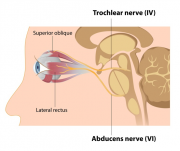Contents |
Fourth Nerve Palsy
Introduction
There are ten cranial nerves, each in charge of a different function, like the sense of smell, the optic nerve, and the one that controls most eye movement. The fourth nerve, the trochlear, is in charge of only one eye muscle, called the superior oblique, which moves each eye downward and inward, with some rotational effect also.
The fourth nerve, also called the trochlear nerve is the longest of the cranial nerves, and the one most sensitive to damage from trauma (head injury) or damage from circulation malfunction, as may be seen in high blood pressure or diabetes. The fourth nerve is also susceptible to malfunction due to genetics and nerve malfunction due to multiple sclerosis. The best treatment for fourth nerve palsy depends on the cause, as some acquired palsies may resolve by themselves over time, while others may require treatment.
The term paresis indicates a partial dysfunction, while palsy is a complete lack of function.
Fourth nerve palsy, also known as trochlear nerve palsy, can be tricky to diagnose because the eyes may at first appear to align normally, but in most cases, there will be some amount of diplopia, or double vision, which may cause people to tilt the head in the direction away from the affected eye. That is, if the palsy or paresis of the superior oblique muscle affects the right eye, the tilt of the head will be to the left, which makes it easier to avoid or reduce constant double vision.
Signs and Symptoms
Although some people with fourth nerve palsy may be asymptomatic, any of the following symptoms and signs may be present:
- Double vision when both eyes are open, and which disappears when one eye is closed or covered.
- Double vision with the two images stacked one above the other, not side-by-side
- Double vision that worsens when looking downwards
- A noticeable head tilt, which helps alleviate the double images
- In straight gaze, the affected eye may appear to look upward
- A sensation that objects appear tilted or rotated rather than straight up and down
- More difficulty when reading or other close-up activities
- Usually fourth nerve or trochlear palsy affects only one eye, but some cases are bilateral.
Three-step testing can help pinpoint the source of diplopia and eliminate possible causes until the muscle dysfunction can be narrowed down to only one.
Treatment
In congenital fourth nerve palsy, eye muscle surgery may be indicated sometime after the patient’s first birthday, to help align the eyes and prevent later vision problems, including head tilting to make it easier to avoid double vision.
If the cause of the palsy is head trauma, surgery should be postponed for at least six months to a year, because sometimes the amount of misalignment may decrease or even disappear. Rather, it may be better to use a type of stick-on prism known as a Fresnel lens, which can be changed as the amount of head tilt and/or diplopia decreases.
The prognosis for recovery of normal function is better in the case of circulatory causes than in head trauma, although even those cases caused by head injury seem to resolve at a rate of about 50%.
While waiting to see if the condition improves on its own, a patch over the affected eye will eliminate the double vision and prevent development of a head tilt to compensate. Either changeable Fresnel stick-on prisms or ground-in lens prisms can be useful to compensate.
If the diplopia is not showing a reduction over time, eye muscle surgery may be indicated, although other interventions should be attempted first.

